Birdfinding.info ⇒ Globally widespread, but uncommon and sporadic over most of its expansive range. Areas where it is usually numerous include: the Gulf of Mexico coastal plain in eastern Texas and southwestern Louisiana; central Florida; Lake Chapala in Jalisco; Lake Yojoa in Honduras; the Guayas River floodplain of Ecuador; and the lower Paraná River Valley of Argentina. In Florida, consistent sites include Lake Apopka and Loxahatchee National Wildlife Refuge.
Fulvous Whistling-Duck
Dendrocygna bicolor
Tropical and subtropical lowlands of the Americas, Africa, and South Asia. Patchily distributed, mainly in areas of extensive marshy wetlands. Partly nomadic, so its occurrence in some regions is sporadic, and some populations appear to fluctuate widely.

Approximate distribution of the Fulvous Whistling-Duck. © BirdLife International 2016
In North and Middle America, occurs on the Pacific coastal plain from Sonora to northwestern Costa Rica; locally in interior valleys of Mexico and Central America; nearly throughout Gulf of Mexico coastal plain (but mostly onthe western side, from Louisiana to Tabasco); and locally along the Caribbean coast in Belize, Guatemala, and Honduras.
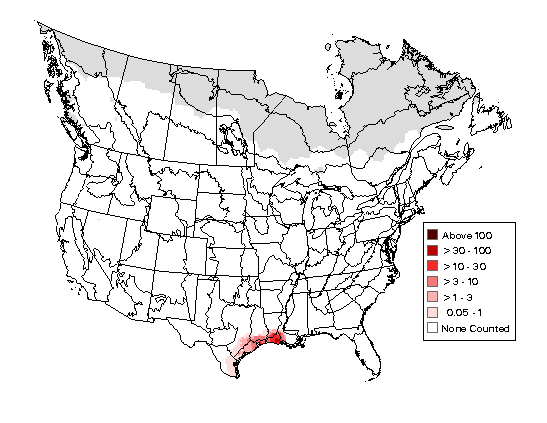
Breeding Bird Survey Abundance Map: Fulvous Whistling-Duck. U.S. Geological Survey 2015
Formerly resident north to southern California, and still a sporadic visitor to California and Arizona. Vagrants regularly wander north of the usual North American range, most often in the southern Mississippi Valley (to southeastern Missouri) and along the southeastern coastal plain to the Carolinas, occasionally reaching the Great Lakes, southern New England, and Bermuda, and exceptionally as far as southwestern British Columbia, Utah, North Dakota, southern Quebec, and New Brunswick.
In the West Indies, resident on Cuba and smaller numbers occur sporadically on Hispaniola and Trinidad. Wanderers sometimes appear on other islands throughout the Caribbean, most often on Puerto Rico and Barbados.
In northwestern South America, occurs in the Pacific lowlands of Colombia, Ecuador, and northwesternmost Peru; Caribbean lowlands of Colombia and northwestern Venezuela; intermontane valleys of Colombia; and the Llanos of Colombia and Venezuela.

Brazilian records by municipality. © WikiAves 2022
In eastern South America, widely distributed across the interior plains from eastern Bolivia and southern Mato Grosso south to eastern La Pampa and southern Buenos Aires Province, and in the Atlantic lowlands north to southern Minas Gerais and Espírito Santo. Also occurs locally farther north throughout the cerrado region and in northeastern Brazil. Wanderers have been recorded at various locations elsewhere in South America: e.g., Surinam, Amazonia, and central Chile.
In Africa: local in the Sahel from southern Mauritania and Senegal east to southern Chad; widespread in the east from southern Sudan and interior valleys of Ethiopia south to the northeastern third of South Africa, and west across Zambia and northern Botswana to southern Angola and northern Namibia; and sporadic along the southern coast of South Africa to Cape Town. There are a few scattered records from elsewhere in western and central Africa. Also resident on Madagascar.
The South Asian population is concentrated mainly in three areas: (1) the coastal lowlands of Tamil Nadu; (2) the Brahmaputra River plains of Assam; and (3) the Irrawaddy River plains of Myanmar. Small numbers occur locally or sporadically elsewhere in eastern India and Bangladesh.
Scattered reports from the Middle East may include both escapees and natural vagrants from Africa or India. There are records from Israel (multiple occasions), southern Saudi Arabia, southern Oman, and along the southern Persian Gulf coast. Likely introduced to Dubai, where small numbers have been present since the late 2010s.
There are at least two accepted records from Morocco, and several recent records from the Iberian Peninsula, mostly Portugal—which may be of uncertain origin, although the Moroccan records suggest a vagrancy pattern that would be consistent with wild origin.
A flock appeared in Hawaii in the 1980s and bred multiple times on Oahu, where several remained into the ‘90s, then vanished. Following initial interpretations that this represented a natural colonization event, careful research revealed that the likely source was an aviculturist on Kauai.
Identification
Cinnamon overall, with a whitish collar, a steely-gray bill, cinnamon barring on black upperparts, and bold whitish or buffy plumes on the flanks.
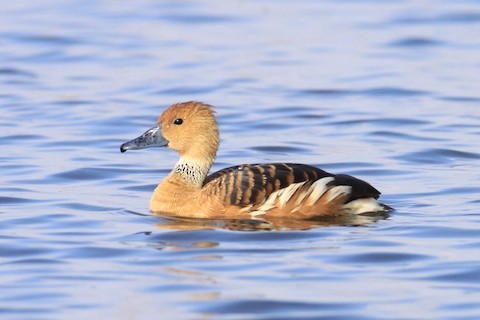
Fulvous Whistling-Duck. (San Bernard National Wildlife Refuge, Texas; February 15, 2009.) © Timothy P. Jones
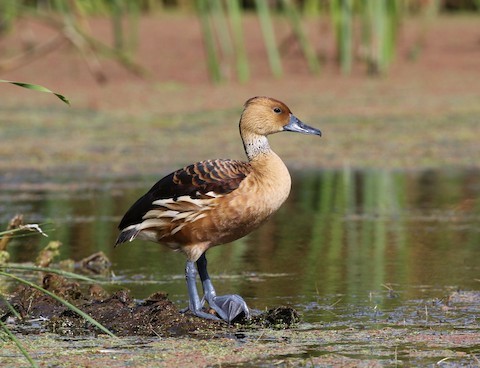
Fulvous Whistling-Duck. (Ballona Wetlands Ecological Reserve, Los Angeles, California; July 12, 2018.) © Tom Benson
On the back of the neck is a thin central blackish stripe. The whitish collar has a furrowed texture, which gives a finely streaked appearance.
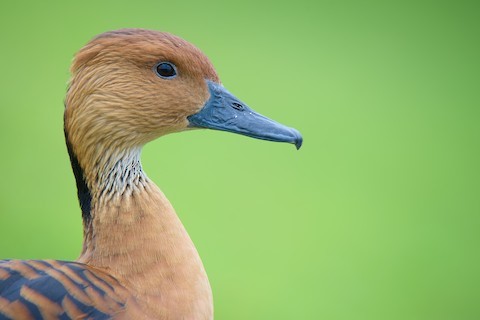
Fulvous Whistling-Duck, showing furrowed whitish collar. (San Rafael, Alajuela, Costa Rica; November 2, 2018.) © Christopher Becerra
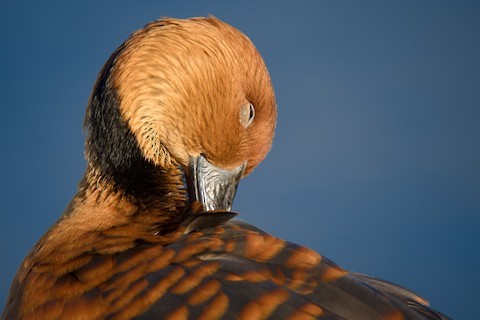
Fulvous Whistling-Duck, preening, showing blackish stripe on the back of the neck. (San Rafael, Alajuela, Costa Rica; February 24, 2019.) © Christopher Becerra
In flight, the extended wings appear all-black except for a subtle chestnut patch on the upper coverts. The lower back and tail are both black, separated by a pale U-shaped rump band.
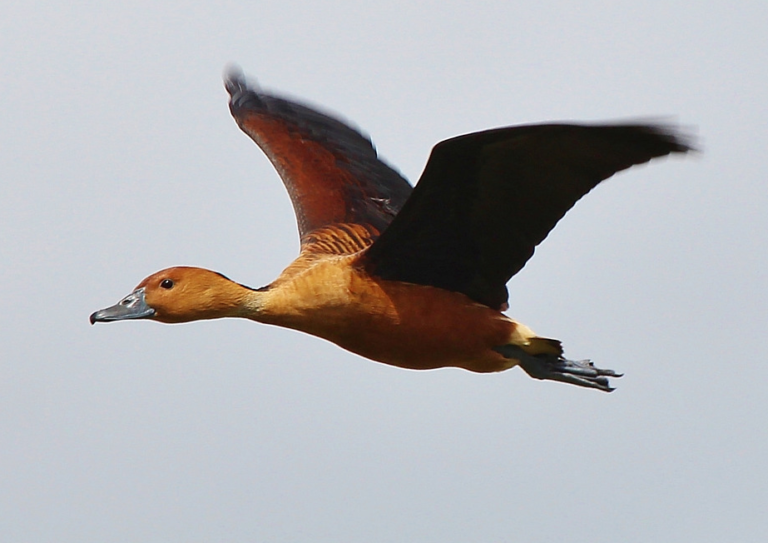
Fulvous Whistling-Duck in flight, showing black wings with chestnut upper coverts. (Pão de Açúcar, Alagoas, Brazil; September 7, 2019.) © Pedro Têia

Fulvous Whistling-Duck, dorsal view in flight, showing pale, U-shaped rump-band. (Balzar, Guayas, Ecuador; August 8, 2020.) © Roger Ahlman
Notes
Monotypic species.
See below for a comparison of the Fulvous Whistling-Duck with the Lesser Whistling-Duck.
Cf. Lesser Whistling-Duck. Fulvous and Lesser Whistling-Ducks occur together in wetlands of the Indian subcontinent. The two are generally similar in overall pattern and coloration, and readily confused at a distance. Fulvous is somewhat larger and more richly colored—an orangish cinnamon, as opposed to tan—but these features can be difficult to assess. The most objectively diagnostic difference is most visible in flight: Fulvous has a pale U-shaped rump-band, whereas Lesser has separate pale bars on either side of its rump.
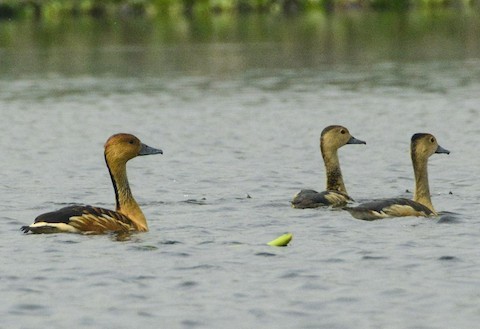
Fulvous Whistling-Duck (at left) with two Lesser Whistling-Ducks. (Purbasthali Bird Sanctuary, Barddhaman, West Bengal, India; February 19, 2021.) © Swarup Saha
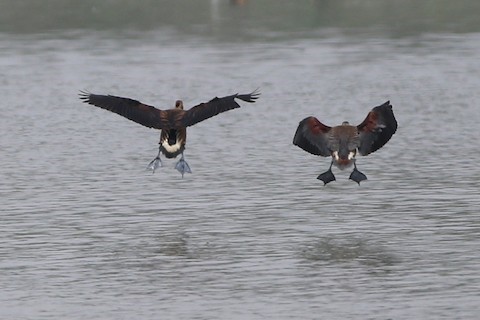
Fulvous Whistling-Duck (at left) with Lesser Whistling-Duck, showing diagnostic difference in rump patterns. (Al Sadd Lake, Jizan, Saudi Arabia; September 4, 2015.) © Khalifa Al Dhaheri
More Images of the Fulvous Whistling-Duck
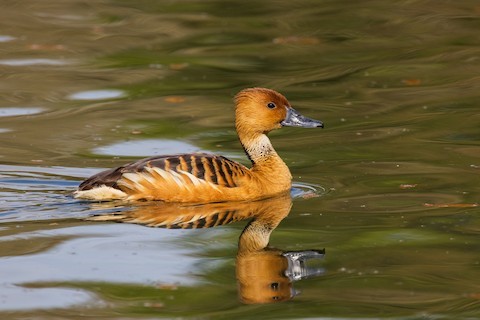
Fulvous Whistling-Duck, showing bright cinnamon coloration. (Audubon Park, New Orleans, Louisiana; March 13, 2021.) © John Ficken
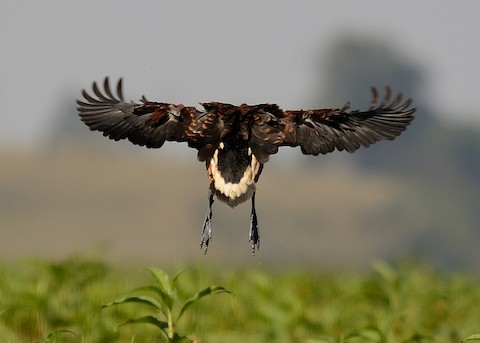
Fulvous Whistling-Duck, dorsal view in flight, showing pale, U-shaped rump-band. (Tanquã, Piracicaba, São Paulo, Brazil; August 16, 2015.) © Rodrigo Ferronato
References
Alderfer, J., and J.L. Dunn. 2014. National Geographic Complete Birds of North America (Second Edition). National Geographic Society, Washington, D.C.
Ascanio, D., G.A. Rodriguez, and R. Restall. 2017. Birds of Venezuela. Christopher Helm, London.
BirdLife International. 2016. Dendrocygna bicolor. The IUCN Red List of Threatened Species 2016: e.T22679746A92827620. https://dx.doi.org/10.2305/IUCN.UK.2016-3.RLTS.T22679746A92827620.en. (Accessed March 20, 2022.)
Borrow, N., and R. Demey. 2004. Birds of Western Africa. Princeton University Press.
eBird. 2022. eBird: An online database of bird distribution and abundance. Cornell Lab of Ornithology, Ithaca, N.Y. http://www.ebird.org. (Accessed March 20, 2022.)
ffrench, R. 2012. A Guide to the Birds of Trinidad & Tobago (Third Edition). Cornell University Press.
Howell, S.N.G., and S. Webb. 1995. A Guide to the Birds of Mexico and Northern Central America. Oxford University Press.
Kirwan, G.M., A. Levesque, M. Oberle, and C.J. Sharpe. 2019. Birds of the West Indies. Lynx Edicions, Barcelona.
Martínez Piña, D.E., and G.E. González Cifuentes. 2021. Field Guide to the Birds of Chile. Princeton University Press.
McMullan, M., and T. Donegan. 2014, Field Guide to the Birds of Colombia (Second Edition). Fundación Proaves de Colombia, Bogotá.
Porter, R.F., S. Christensen, and P. Schiermacker-Hansen. 1996. Field Guide to the Birds of the Middle East. T & A D Poyser, London.
Pyle, R.L., and P. Pyle. 2017. The Birds of the Hawaiian Islands: Occurrence, History, Distribution, and Status. Version 2 (January 1, 2017). http://hbs.bishopmuseum.org/birds/rlp-monograph/. B.P. Bishop Museum, Honolulu, Hawaii.
Raffaele, H., J. Wiley, O. Garrido, A. Keith, and J. Raffaele. 1998. A Guide to the Birds of the West Indies. Princeton University Press.
Redman, R., T. Stevenson, T., and J. Fanshawe. 2009. Birds of the Horn of Africa: Ethiopia, Eritrea, Djibouti, Somalia, and Socotra. Princeton University Press.
Ridgely, R.S., and P.J. Greenfield. 2001. The Birds of Ecuador, Volume II: Field Guide. Cornell University Press.
Ridgely, R.S., and J.A. Gwynne. 1989. A Guide to the Birds of Panama (Second Edition). Princeton University Press.
Schulenberg, T.S., D.F. Stotz, D.F. Lane, J.P. O’Neill, and T.A. Parker. 2007. Birds of Peru. Princeton University Press.
Sibley, D.A. 2014. The Sibley Guide to Birds (Second Edition). Alfred A. Knopf. New York.
Sinclair, I., and P. Ryan. 2003. Birds of Africa South of the Sahara. Princeton University Press.
Sinclair, I., P. Hockey, W. Tarboton, and P. Ryan. 2011. Birds of Southern Africa (Fourth Edition). Random House Struik (Pty) Ltd. Cape Town, South Africa.
Svensson, L., K. Mullarney, and D. Zetterström. 2009. Birds of Europe (Second Edition). Princeton University Press.
Wikiaves. 2022. Marreca-caneleira, https://www.wikiaves.com.br/wiki/marreca-caneleira. (Accessed March 20, 2022.)
Xeno-Canto. 2022. Fulvous Whistling Duck – Dendrocygna bicolor. https://xeno-canto.org/species/Dendrocygna-bicolor. (Accessed March 20, 2022.)
